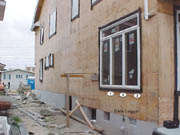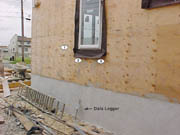Moisture entry has been found to occur in homes with all types of claddings. Regardless of the cladding type, it's often difficult to visually determine if a structure has been subject to moisture entry unless there is obvious damage or a known source. Structures can be intrusively investigated by removing sections of cladding to determine this; however, it can be costly and disruptive to the occupants.
The two most common alternatives to an intrusive investigation that can be used on some claddings are a scanning or noninvasive-type instrument, such as a capacitance-type meter, or an electrical probe or resistance-type meter. Both evaluation methods generally provide a snapshot view of building performance rather than a view over an extended time period.

Send in the probe
A scanning or noninvasive-type instrument requires the user to move the handheld equipment over the surface of the cladding. Outgoing and incoming electronic signals are used to record different levels of penetration through the materials. It is capable only of locating general areas of potential moisture and often provides relative, rather than quantitative, data. Because of this, it is subject to interpretation and requires additional investigation if areas of moisture appear evident. Additionally, this method does not identify the wall component that contains the moisture and can also provide false positive readings.Electrical probe or resistance-type meters penetrate the cladding with a two-pronged pin that enters the surface of the underlying substrate material. It functions on the principle of electrical resistance and provides direct percent moisture content readings in common, underlying, substrate materials. Although this is a commonly used method, it creates small, intrusive probe holes in the cladding that must be repaired. Results obtained from probe-type instruments can be skewed by items such as recent precipitation, surface moisture, and depth of probes in the substrate. Some interpretation will be needed for assemblies that incorporate a secondary weather barrier over the underlying substrate since the location of moisture may be difficult to determine.
In an effort to record data that would allow evaluation of underlying substrate conditions over a period of time in a non-intrusive manner, the author, along with the company's engineering department, developed a method and tested a data logger to meet these needs. This methodology was utilized with a drainage-type EIFS but presumably could be adapted for use with other cladding systems as well.
A four-channel outdoor/industrial data logger was selected as a means to record the data. Pulses are sent from the data logger via a dedicated lead or cable that also contains a "switch." The switch consists of two leads, or poles, a specific distance apart and mounted with stainless steel screws to the underlying substrate. If there is moisture in the underlying substrate at the specific location, the pulse is returned through the switch back to the logger, which records voltage. The voltage measurement corresponds with the amount of moisture present, as determined in independent lab testing.
The lab testing was conducted to correlate voltage drops to percent moisture contents in common wood-based sheathing substrate materials. A maximum of 20 percent moisture content in the underlying wood-based sheathing substrate is considered an acceptable moisture level since untreated wood will have indefinitely long service without decay if the moisture content remains below that level (American Institute of Timber Construction).
Each of the four leads on a logger is typically placed in areas that have been subject to moisture entry in the past, such as below windows, flashings, etc. At least one lead is placed in an area that is not anticipating any moisture to be used as a control. The loggers (approximately 140 millimeters by 140 millimeters) are typically mounted on a small post set in the ground. Readings are downloaded from the data loggers via a shuttle data transporter, providing the means to transport data recorded from the project to a computer.

Jersey job
The first field study using the data loggers started in 2000, when several houses in the northeast and in the Carolinas had them installed. For discussion purposes, this article will analyze a new construction project in Bricktown, N.J.Located on an inlet along the East coast of N.J., this three-story wood-frame home with plywood sheathing was clad with a drainage-type EIFS. The data logger system leads were installed over the substrate in July 2000 and were programmed to record daily readings at eight-hour intervals. All leads, except one, were located at window mullions or jamb/sill intersections since these were areas of typical windows that have been subject to water infiltration in the past. The weather-resistive barrier was installed in August, followed by the drainage-type EIFS in the fall of 2000.
The first set of data (from July 2000 to February 2001) was collected from both loggers in February 2001. Both loggers showed essentially flat line graphs after the early part of September, which indicates little or no change in moisture content of the underlying substrate. The maximum voltage drop was less than .05 volts, which, based on trend lines for plywood sheathing, correlates to percent moisture contents that are significantly less than 20 percent which is not a concern for wood decay. The spikes and higher voltage readings prior to September are attributed to the fact that the loggers were directly exposed to rainfall prior to the installation of the weather barrier, cladding, flashings, etc.
Once the complete wall system was in place (September), the voltage levels were consistently less than .05. This drop in moisture content after the installation of the cladding also indicates drying of the underlying substrate.
The project continues to be monitored today, with recordings up to August 2004. The recordings continue to demonstrate measurements that correlate to percent moisture contents significantly less than 20 percent.
Data loggers or acquisition systems, such as the one used in this study are an alternative method to gather data and monitor building performance. Advantages over some of the current methods include the ability to gather numerous data points over an extended period of time without continuous site visits and the non-intrusive method of installing the recording devices prior to installing the cladding.
For this study, many samples and conditions were used to determine the trend lines generated from the independent lab testing. The main concern of this study was to determine moisture content greater than 20 percent but the sensitivity of the meters could be enhanced to track lower levels.
With respect to performance of EIFS clad dwellings, the information obtained from this study is an additional means to demonstrate that a properly installed building envelope, including flashings, weather barrier, etc., can protect the underlying substrate from excess moisture. Although this study was limited in scope, it provides supplemental support to existing testing as well as successful projects that show the viability of this cladding system.
